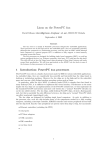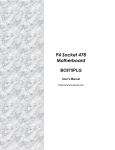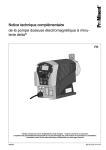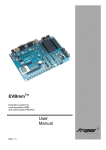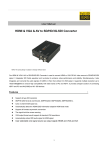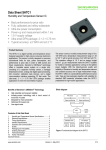Download Paper
Transcript
Linux on the eLAP David Gibson OzLabs, IBM Linux Technology Center <[email protected]> <[email protected]> Abstract they have some notable differences from “classic” PowerPC CPUs (as used in IBM pSeriesTM servers and Apple workstations). The 4xx CPUs operate at much lower clock rates (and hence are cooler and cheaper), although they are in the high end by embedded standards. They have a much simpler MMU (just a software loaded TLB) and they have no floating point unit. More interestingly, the 4xx CPUs include a number of peripheral devices built into the CPU die itself (hence the term “system-on-chip”). Different CPUs in the family are designed for different applications and so have different sets of onchip peripherals. The 405LP is aimed at handheld, battery-powered applications and includes an LCD controller, PCMCIA/Compact Flash controller and real time clock along with more general purpose devices. Other 4xx chips can include devices such as Ethernet controllers, HDLC interfaces, PCI host bridges, IDE and USB controllers. The 405LP also includes a number of features to reduce power consumption, some of which are quite novel. The chip’s base power consumption is already quite low: it will run at 266MHz with no heatsink or fan. The various on-chip devices can be individually turned on and off, saving power when they are not in use. In addition, the CPU clock speed and the frequencies of the several internal buses can be adjusted while the CPU is operating. This allows the OS to adjust the CPU’s compute and IO performance, allowing a high peak performance when necessary, but keeping power usage to a minimum the rest of the time. This adjustment can be done quickly (microseconds in many cases), and without disrupting the running system, which allows the system to take advantage of even brief periods of inactivity to save power. The 405LP can also operate at a number of differ- r r The IBM PowerPC 405LP is an embedded CPU designed especially for handheld applications. Like other PowerPC 4xx CPUs, it includes a number of peripheral devices built into the CPU die itself, such as an LCD controller, PCMCIA controller and serial ports. The 405LP also includes a number of novel power management features. As well as being able to power on and off the various chip components as necessary, it can adjust the CPU core and internal bus frequencies with very low latency allowing the the chip to provide high performance when necessary, but low-power operation the rest of the time. The IBM PowerPC 405LP PDA Reference Design, also known as the Embedded Linux Application Platform, or eLAP, is a sample board made by IBM based on the 405LP (see [4] or [7]). It is designed to run Linux and demonstrate the 405LP’s capabilities. It is expected that handheld devices derived from this design will be made and sold by third parties. The hardware in this device is very different from a typical PC or server, so we examine what is involved in getting Linux to deal with the device’s peculiarities and take advantage of the hardware’s features. We pay particular attention to power management. 1 1.1 The hardware The CPU The IBM PowerPC 405LP is a CPU from the PowerPC 4xx family. This series of CPUs is designed for “system-on-chip” embedded applications. As the name suggests these processors are implementations of the PowerPC ArchitectureTM , however 1 ent voltages, and the voltage can also be adjusted while the CPU is running (although with much higher latency). With appropriate board-level support, this allows for further savings in power consumption. Power usage is directly proportional to the frequency, but to the square of the operating voltage (for a fixed frequency). The maximum frequency is roughly proportional to the voltage. Thus, voltage scaling can achieve much greater power savings than frequency adjustment alone. 1.2 opment for this has mostly been done by IBM and MontaVista Software building on the code supporting other PowerPC 4xx processors which has existed for some time1 . Unfortunately, for various historical reasons, the code for the eLAP has not yet been merged into the standard 2.4 or 2.5 Linux development trees. In fact what little 4xx support is in the 2.4 tree is broken, and the 4xx code in 2.5 is quite incomplete. Eventually the 4xx and eLAP code should be merged back into the mainstream trees — once someone can find the time to do the necessary cleanups, consolidation and merging. For now, most of the development for 4xx based machines, including the eLAP, takes place in the linuxppc 2 4 devel BitKeeper tree ([1]). MontaVista Software maintains a distribution for embedded devices, which has been used as the basis for the userspace software on the eLAP. This distribution also includes a kernel which includes the eLAP and other 4xx support from linuxppc 2 4 devel (or at least will in a future release). It also includes a few extra pieces for the eLAP which have not yet been merged into the linuxppc 2 4 devel tree. The eLAP The IBM PowerPC 405LP PDA Reference Design (also known as the Embedded Linux Application Platform or eLAP) is, as the name suggests, a handheld design based on the 405LP and designed to demonstrate the CPU’s capabilities in a handheld device. Figure 1 shows a block diagram of the eLAP, including the devices built into the 405LP itself. In addition to the devices within the 405LP, the eLAP includes some RAM and flash memory and a number of additional peripherals. Most of these are connected via a simple bus driven by the 405LP’s on-chip External Bus Controller (EBC) unit. In particular it has several ways of attaching further external devices: in addition to the PCMCIA controller built into the 405LP, the eLAP has both a socket for Secure Digital (SD) memory and IO cards and a Phillips ISP1161 USB interface. This chip is both a USB host controller (allowing USB devices like keyboards and mice to be connected to the eLAP) and a USB client interface (allowing the eLAP to be connected to a PC as a USB device). An extra debug and development sled can be attached to the eLAP, also shown in Figure 1. It includes an Ethernet controller, the physical PCMCIA slot driven by the 405LP’s PCCF core and the physical connectors for the USB host port and serial port. 2 2.1 Booting and the basics As a handheld device, the eLAP is designed to boot from flash memory. The eLAP’s flash is wired so that the CPU will execute the eLAP firmware, PIBS (PowerPC Initialization and Boot Software), from flash at power-on. PIBS performs some basic hardware configuration (such as initialising the 405LP’s SDRAM controller) then boots the Linux kernel. It does this by loading the kernel image into RAM then jumping to it, much as LILO does on a normal PC. Usually the kernel image is stored in another section of flash, but for development purposes PIBS can also load a kernel over the serial port, or (if the development sled is attached) over Ethernet. The kernel image will usually include an initial ramdisk with a basic userland for the device. The startup scripts will then usually mount a JFFS2 filesystem which takes up the remainder of the flash memory and contains the rest the userspace programs and data. For development it is also possible to use an Current support As the name “Embedded Linux Application Platform” suggests, the eLAP is intended to have Linux as its OS. Although work is still in progress in some areas, kernel support now exists for most of the hardware and features of the device. The devel- 1 [5] 2 covers Linux 4xx support more generally. 405LP PowerPC 405LP PDA Reference Design (eLAP) Debug Sled 32MB SDRAM SDRAM External Bus EBC Buffers PCMCIA Ethernet MAC Ethernet USB Gadget USB USB Host PCCF MDOC RTC SDIO SDIO Tricolour LED LED Ctrl CPM FPGA Buttons APM TCPA 32MB NOR Flash LCDC LCD Panel TDES POB On−board Peripheral Bus (OPB) Processor Local Bus (PLB) Device Control Register (DCR) Bus IIC DMAC Battery ADC Frontlight Touchpanel I2C Bus Frontlight Ctrl CSI Speakers Audio Codec Microphone UART1 Line in/out TS Ctrl. UART0 RS232 PLB GPIO UIC PowerPC 405 Core OPB External Bus External connection I2C Bus DCR Bus Other connection Physical device Socket Interrupt Line APM Audio Codec Battery ADC CPM CSI DMAC EBC Ethernet MAC Frontlight Ctrl GPIO IIC LED Ctrl LCDC Power management unit, implements the CPU sleep/suspend states (NB: this is not related to the APM BIOS in PC laptops) Texas Instruments TLV320AIC23 stereo audio codec ADS7823 ADC monitoring battery voltage Clock and Power Management unit Codec Serial Interface (interface to audio codec devices) DMA controller (can DMA to/from devices on both the PLB and OPB) External Bus Controller RTL8109 Ethernet controller DS1050 LCD frontlight controller General Purpose IO interface I2 C bus interface (both master and slave capable) BU8770KN tricolour LED driver LCD display controller MDOC PCCF POB RTC SDIO SDRAM TCPA TDES TS Ctrl UARTx UIC USB 64M of M-Systems Millennium Plus Disk-on-Chip (NAND flash with specialised controller) PCMCIA and Compact Flash controller (16-bit only, not CardBus) PLB-to-OPB bridge Real Time Clock Toshiba TC6380AF Secure Digital and SDIO interface SDRAM controller Atmel AT97SC3201 TPM Triple-DES accelerator Semtech UR7HCT52 S840L touchscreen controller NS16550 compatible UARTs Universal Interrupt Controller Phillips ISP1161 USB interface (includes both host controller and target interface) Figure 1: Block diagram of the eLAP NFS root filesystem. 2.2 The kernel includes drivers for the 405LP’s built in serial ports, and uses one of these (UART0) for the console. Of course the console is only expected to be used for development and debug. The kernel also has full support for the 405LP’s LCD controller (framebuffer device) and the Semtech touchscreen controller attached to the second serial port. The normal interface to the device is through the Qtopia GUI running on the handheld’s built in LCD display. In addition to the devices needed for basic operation, most of the peripherals on the 405LP and the rest of the eLAP are supported in the linuxppc 2 4 devel tree. The 405LP’s real-time clock and GPIO lines are fully supported, as is its PCCF (PCMCIA and Compact Flash) controller which drives the PCMCIA slot in the eLAP’s development sled. Likewise the I2 C interface (IIC) is supported as are the eLAP’s I2 C devices. The TI audio codec which is controlled via I2 C is supported 3 Bells and whistles in conjunction with the 405LP’s CSI, to form a complete audio device. The eLAP’s buttons and its multicolour LED, accessed via a custom FPGA, are both supported, as is the RTL8019 Ethernet on the development sled. The Phillips USB chip is partially supported. There is a driver for the host controller side of the chip, although this has not been merged into the linuxppc 2 4 devel tree (it is in MontaVista’s kernel). Similarly a driver for the Atmel TCPA chip exists, but only has an external module which has not been merged into the development tree. In any case the driver is of very limited use without considerable userspace library support, which is still in progress. A driver for the Toshiba SDIO chip has been written by Toshiba with IBM’s assistance, but is only available in binary form. SD Association rules prevent Toshiba from releasing specifications to write an open source driver, with luck this will change eventually. The 405LP’s triple-DES accelerator (TDES) is also unsupported thus far. It is quite a simple device to operate, however, and a driver should appear in due course — so far it has not had a high priority. 3.2 Power management The obvious importance of reducing power consumption in a battery powered device makes support for power management on the eLAP particularly interesting. A number of power management techniques are already supported on the device, but work continues to best take advantage of the 405LP’s features in this area. The simplest form of power management supported by the eLAP is suspend and resume, that is, powering off most of the device while preserving the state of the OS and applications. This is just like the “sleep” modes supported on most laptops. The 405LP’s APM core supports several different methods of preserving the CPU state. 3 Continuing and future work In the eLAP, suspend-to-RAM is implemented by saving the CPU’s register state to RAM, ensuring caches are flushed, then switching the SDRAM 3.1 Missing drivers into a self-refresh mode to preserve its contents. Although, as we have seen, most of the the eLAP’s The device is then powered off, except for the RAM hardware is already supported, a few devices still and the power management units themselves. The lack drivers. The most obvious of these is the suspend code also records a special flag in an unM-Systems Disk-on-Chip (MDOC), which com- used bit in one of the real time clock registers prises the bulk of the handheld’s storage. A (which are preserved while the device is off, of driver for this device, developed by M-Systems and course), and stores a pointer to a restore routine at adapted for the eLAP with IBM and MontaVista’s a fixed address in memory. When the device is powassistance, does now exist. Unfortunately a num- ered on again, the PIBS firmware checks the flag to ber of technical hitches — hardware and software determine that the device has been suspended and — have delayed getting problems ironed out of this instead of booting normally passes control to the driver. The most difficult problems now seem to Linux restore routine. This restores the register have been resolved, so MDOC support should be state from memory and resumes running. In order for this to work properly, device drivers working in the near future. also need to shut down devices before suspending, Using the USB target side of the Phillips USB then re-initialise them and restore their state after chip — allowing the eLAP to act as a USB device — resume. The most important eLAP drivers, such as is, as yet, wholly unsupported. Adding support for the LCDC driver do this already, but some other this is made more difficult by the fact that, unlike drivers still need to have suspend support added. USB host controller support, USB gadget support Similarly, some drivers already support powering is not yet in the mainstream kernel trees. However, the device they control off when possible to save 2 some groups, notably Lineo , have worked on USB power. Other drivers still need to be enhanced to gadget support, so it should be possible to use this save power in this manner. The power to the onwork as a basis for a driver for the eLAP. chip devices is controlled by the Clock and Power 2 See http://opensource.lineo.com/usb/ Management (CPM) core, while power to most of 4 the off-chip devices is controlled by registers in the FPGA or by GPIO lines. grams could give hints to the policy manager to let it better anticipate their performance requirements. For example, a video playback program might inform the policy manager that it needs a certain 3.2.1 Dynamic Power Management amount of compute time in order to maintain full Of course, by far the most interesting aspect of speed playback. The problem is complicated by the fact that some power management on the 405LP is its ability to devices in the system may only operate properly at adjust operating frequency and voltage while runcertain bus frequencies. These devices place conning. Linux support for this is under continuing straints on what operating points can be selected development by IBM and MontaVista. This and when they are active. The scheme in [2] allows other means of saving power while the machine drivers to register these constraints with the DPM is running are known as “dynamic power managesubsystem so that they can be properly taken into ment” (DPM). account. This simplest way of using this capability is to allow the user to explicitly select a particular frequency and voltage mode, and this mode of oper- 3.3 Consolidation and cleanups ation is already supported. This approach is analogous to that used by the cpufreq3 project which In addition to ongoing work to add support for curallows frequency adjustment on a number of other rently missing features on the eLAP, some work on CPUs (although the 405LP implementation is, for consolidation and cleanup of the existing code will now, independent of the cpufreq infrastructure). be needed as the eLAP support is merged back into However this fails to really make use of the 405LP’s the main kernel trees. Many of the problems faced abilities: because the 405LP can adjust frequency supporting the eLAP also affect other PowerPC 4xx with particularly low latency we want to take ad- based machines or other embedded devices genervantage of this by automatically adjusting the fre- ally. This work is somewhat delayed by the need for consolidation and cleanup of the general PowerPC quency to match runtime requirements. How to best automatically manage frequency and 4xx kernel code. Most of the devices on the eLAP— particularly voltage scaling is still under active investigation. A those built into the 405LP — are quite different to promising scheme developed at IBM’s Austin Rewhat would be found on a normal PC or server masearch Lab is described in [2] and partially implechine. They are neither “standard” devices for the mented for the eLAP. architecture nor devices found on a standard bus, The essence of this approach is for the kernel to such as PCI, which can be systematically probed. keep track of which “operating state” it is in at At the moment the kernel locates most of these any moment. The operating states include things devices by ad-hoc methods. Many of the drivers such as “idle”, “executing user code”, “executing are eLAP specific and “just know” that a particular an interrupt handler” and so forth. If different prodevice exists at a particular address. This approach cesses on the system have different compute or IO quickly becomes messy as the kernel supports more requirements they could have different operating embedded machines — especially when a particular states e.g., “IO intensive task” or “compute intenperipheral is included in multiple embedded devices sive task”. connected in slightly different ways. When the operating state changes, the kernel The 4xx code in the linuxppc 2 4 devel tree consults a DPM “policy” to map the new state to includes a partial solution to this problem for the an “operating point” — that is, a set of frequency on-chip devices: the OCP (for “On-Chip Periphand voltage parameters. The DPM policy can itself eral”) subsystem uses a table of devices for a particbe changed at runtime in order to adapt to longer ular CPU to properly initialise each of the drivers, term changes in performance requirements. This is which can be common across multiple 4xx CPUs. handled by a userspace program known as a DPM However, this system has a number of implemenpolicy manager. Suitably modified application protation problems and an improved and consolidated 3 See http://www.brodo.de/cpufreq_old/ approach handling both on and off-chip embedded 5 About the author devices is needed. [6] covers this topic in more detail. Finally, the eLAP power management code is quite 405LP specific at the moment. However, it has a certain amount of overlap with the functionality of the cpufreq mechanism. The techniques used on the eLAP are also likely to be applicable to more embedded machines in the future. At some point, thus, the power management code will need consolidation into a flexible and portable dynamic power management framework, though this might be best left until it is better understood what techniques work well in practice. David Gibson is an employee of the IBM Linux Technology Center, working from Canberra, Australia. Most recently he has been working on board and device bringup for Linux on embedded PowerPC machines, along with various bits of kernel infrastructure for cleanly supporting PowerPC 4xx and other system-on-chip CPUs. He is also the author and maintainer of the orinoco driver for Prism II based 802.11b NICs. In the past he has worked on ramfs (as included in the -ac kernel tree), and “esky”, a userspace implementation of checkpoint/resume. References Legal Statement [1] linuxppc 2 4 devel kernel tree. bk://ppc@ ppc.bkbits.net/linuxppc_2_4_devel. This work represents the view of the author and does not necessarily represent the view of IBM. IBM, PowerPC, PowerPC Architecture and pSeries are trademarks or registered trademarks of International Business Machines Corporation in the United States and/or other countries. Linux is a registered trademark of Linus Torvalds. Other company, product, and service names may be trademarks or service marks of others. [2] H. Blanchard, B. Brock, M. Locke, M. Orvek, R. Paulsen, and K. Rajamani. Dynamic power management for embedded systems. http://www.research.ibm.com/arl/ projects/papers/DPM_V1.1.pdf, 2002. r [3] IBM Corporation. PowerPC 405LP Embedded Processor User’s Manual, preliminary edition, 2002. [4] Bruce Gain. Handheld multimedia: the Linux connection. Tom’s Hardware Guide, 2003. http://www6.tomshardware.com/business/ 20030129/linuxworld-02.html#handh%eld_ multimedia_the_linux_connection. [5] David Gibson. Linux on the powerpc 4xx. In Conference Proceedings AUUG2002: Measure, Monitor, Control, 2002. http://www.auug.org.au/winter/auug2002/ AUUG2002-proceedings.ps.gz. [6] David Gibson. Device discovery and power management in embedded systems. In Proceedings of the Ottawa Linux Symposium, 2003. [7] Linuxdevices.com. IBM unveils Linux-based PDA reference design. Linuxdevices.com, 2003. http://www.linuxdevices.com/news/ NS9222005703.html. 6








